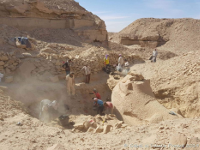|
Amenhotep III Criosphinx Found Abandoned in Quarry
February 27, 2019
Archaeologists have found a sandstone ram-headed sphinx that was abandoned in a quarry more than 3,000 years ago, during the reign of Amenhotep III. The workers found the 11.5-foot-tall sphinx at Gebel el-Silsila, a quarry near Aswan. Also among the finds was a uraeus, a carving of a cobra that is considered a symbol of royalty and is thought to have once sat atop the sphinx. They also found a smaller sphinx and a number of hieroglyph-covered stone fragments from a collapsed shrine of Amenhotep III, the pharaoh who ruled Egypt in the 14th Century B.C., during what is known as the New Kingdom. The sphinx is a criosphinx, one with a ram's head. The more famous sphinx with a human head is called an androsphinx. The criosphinx was abandoned in ancient times. Archaeologists do not know why. Amenhotep III was known as a benevolent ruler who presided over a relatively peaceful and prosperous period in ancient Egyptian history. This enabled the pharaoh and his people to focus on building, which they did with a flourish. The famed Temple of Amen resulted from this time. Much of this temple can still be seen, including the relief showing the royal birth scene that purports to show Amenhotep's appearance directly from the presence of Amen, the king of the Egyptian gods. Other major buildings included a large temple at Soleb and the Thebes palace complex, which connected to the Nile via a huge artificial harbor. He is also the pharaoh depicted in the most surviving statues, including the famous Colossi of Memnon. Archaeologists restored two statues depicting him and his wife, Queen Tiye, and another statute showing the pharaoh midstride at Luxor in 2014. He is perhaps more well-known for his famous son Akhenaten and famous grandson Tutankhamen ("King Tut"). The site Gebel el-Silsila, along the Nile, is also known to be home to a number of quarry workers and their families, recent research has found. The archaeologists have also discovered at the site a necropolis and carved statues of important officials. |
Social Studies for Kids |
Social Studies for Kids
copyright 2002–2024
David White






